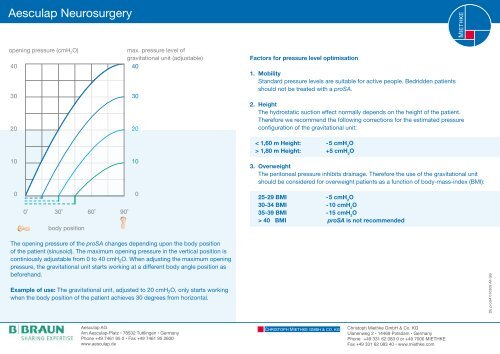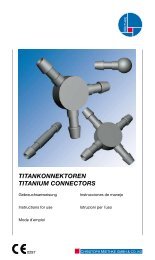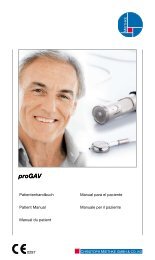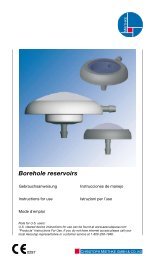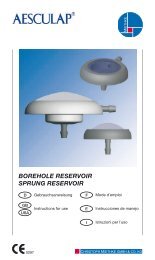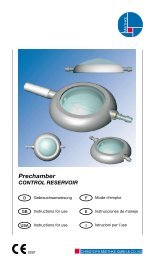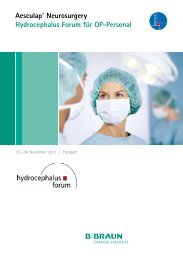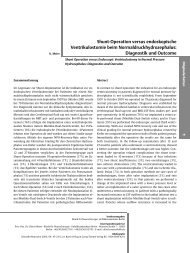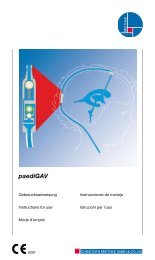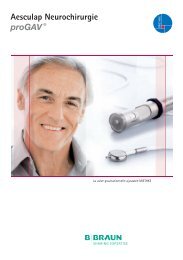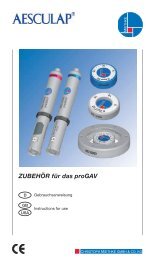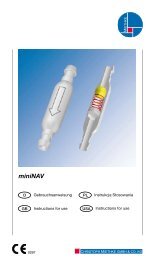recommendation of pressure levels proSA (pdf - Christoph Miethke ...
recommendation of pressure levels proSA (pdf - Christoph Miethke ...
recommendation of pressure levels proSA (pdf - Christoph Miethke ...
You also want an ePaper? Increase the reach of your titles
YUMPU automatically turns print PDFs into web optimized ePapers that Google loves.
Aesculap Neurosurgery<br />
opening <strong>pressure</strong> (cmH2O) max. <strong>pressure</strong> level <strong>of</strong><br />
gravitational unit (adjustable)<br />
40<br />
40<br />
30<br />
20<br />
10<br />
0<br />
0˚ 30˚ 60˚ 90˚<br />
body position<br />
The opening <strong>pressure</strong> <strong>of</strong> the <strong>proSA</strong> changes depending upon the body position<br />
<strong>of</strong> the patient (sinusoid). The maximum opening <strong>pressure</strong> in the vertical position is<br />
continiously adjustable from 0 to 40 cmH 2O. When adjusting the maximum opening<br />
<strong>pressure</strong>, the gravitational unit starts working at a different body angle position as<br />
beforehand.<br />
Example <strong>of</strong> use: The gravitational unit, adjusted to 20 cmH 2O, only starts working<br />
when the body position <strong>of</strong> the patient achieves 30 degrees from horizontal.<br />
30<br />
20<br />
10<br />
0<br />
Aesculap AG<br />
Am Aesculap-Platz • 78532 Tuttlingen • Germany<br />
Phone +49 7461 95 0 • Fax +49 7461 95 2600<br />
www.aesculap.de<br />
Factors for <strong>pressure</strong> level optimisation<br />
1. Mobility<br />
Standard <strong>pressure</strong> <strong>levels</strong> are suitable for active people. Bedridden patients<br />
should not be treated with a <strong>proSA</strong>.<br />
2. Height<br />
The hydrostatic suction effect normally depends on the height <strong>of</strong> the patient.<br />
Therefore we recommend the following corrections for the estimated <strong>pressure</strong><br />
configuration <strong>of</strong> the gravitational unit:<br />
< 1,60 m Height: - 5 cmH 2 O<br />
> 1,80 m Height: +5 cmH 2 O<br />
3. Overweight<br />
The peritoneal <strong>pressure</strong> inhibits drainage. Therefore the use <strong>of</strong> the gravitational unit<br />
should be considered for overweight patients as a function <strong>of</strong> body-mass-index (BMI):<br />
25-29 BMI - 5 cmH 2 O<br />
30-34 BMI - 10 cmH 2 O<br />
35-39 BMI - 15 cmH 2 O<br />
> 40 BMI <strong>proSA</strong> is not recommended<br />
CHRISTOPH MIETHKE GMBH & CO. KG<br />
<strong>Christoph</strong> <strong>Miethke</strong> GmbH & Co. KG<br />
Ulanenweg 2 • 14469 Potsdam • Germany<br />
Phone +49 331 62 083 0 or +49 7000 MIETHKE<br />
Fax +49 331 62 083 40 • www.miethke.com<br />
MIETHKE<br />
DE <strong>proSA</strong> 010309 A4 GB
Aesculap Neurosurgery<br />
Recommendation for <strong>proSA</strong> ®<br />
opening<br />
<strong>pressure</strong> <strong>of</strong> the<br />
whole shunt<br />
system<br />
Horizontal position<br />
Differential <strong>pressure</strong> unit<br />
In the horizontal position the gravitational unit doesn‘t have any<br />
resistance. Only the differential <strong>pressure</strong> unit determines the<br />
opening <strong>pressure</strong> <strong>of</strong> the whole shunt system.<br />
As standard configuration we recommend a differential<br />
<strong>pressure</strong> unit with opening <strong>pressure</strong> <strong>of</strong> 5 cmH 2 O.<br />
opening <strong>pressure</strong><br />
differential <strong>pressure</strong> unit<br />
with differential <strong>pressure</strong> unit*<br />
opening <strong>pressure</strong><br />
gravitational unit<br />
The <strong>recommendation</strong>s are based on common patient treatments, but can vary depending on the individual patient´s condition.<br />
Gravitational unit<br />
Vertical position<br />
In the vertical position the opening <strong>pressure</strong> <strong>of</strong> the complete shunt<br />
system is the sum <strong>of</strong> the opening <strong>pressure</strong> <strong>of</strong> the differential unit<br />
and the opening <strong>pressure</strong> <strong>of</strong> the gravitational unit. The opening<br />
<strong>pressure</strong> <strong>of</strong> the gravitational unit should be chosen depending on<br />
height, weight and age <strong>of</strong> the patient.<br />
Our <strong>recommendation</strong> is as follows:<br />
opening <strong>pressure</strong><br />
differential <strong>pressure</strong> unit<br />
MIETHKE<br />
<strong>recommendation</strong> opening <strong>pressure</strong><br />
gravitational unit<br />
children up to 5 years 20 cmH2O 5 cmH2O + 0 cmH2O opening<br />
opening<br />
<strong>pressure</strong> <strong>of</strong> the <strong>pressure</strong> <strong>of</strong> the adults up to 60 years = =<br />
+<br />
25 cmH2O whole shunt differential unit<br />
without differential unit<br />
system<br />
adults over 60 years 20 cmH2O 0 cmH2O + 0 cmH2O *as special configurations in addition to the standard configuration, differential <strong>pressure</strong><br />
units with <strong>pressure</strong> <strong>levels</strong> 0,10,15 cmH 2 O are available.


